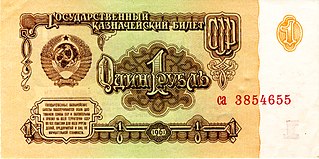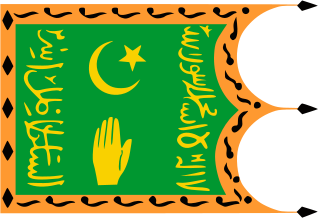Related Research Articles

The Russian ruble or rouble is the currency of the Russian Federation, the two partially recognised republics of Abkhazia and South Ossetia and the two unrecognised republics of Donetsk and Luhansk. The ruble is subdivided into 100 kopeks.

The tenge is the currency of Kazakhstan. It is divided into 100 tiyn. The ISO-4217 code is KZT.

The soʻm is the currency of Uzbekistan in Central Asia.

Bukharan Jews, in modern times more commonly called Bukharian Jews, are an ethnoreligious Jewish sub-group of Central Asia that historically spoke Bukharian, a Judeo-Tajik dialect of the Tajik language, in turn a variety of the Persian language. Their name comes from the former Central Asian Emirate of Bukhara, which once had a sizable Jewish population.

The Belarusian ruble or rouble is the official currency of Belarus. The ruble is subdivided into 100 copecks.
Bukharian also known as Bukhari, Judeo-Tajik, Judeo-Tadzhik, Bukharic, and Bukharit is the Judeo-Tajik dialect historically spoken by Bukharian Jews. It is a Jewish dialect derived from —and largely mutually intelligible with— the Tajik branch of the Persian language.

The Soviet ruble was the currency of the Russian Soviet Federative Socialist Republic (RSFSR) from 1917 and later the Union of Soviet Socialist Republics (USSR). One ruble (рубль) was divided into 100 kopeks. Many of the ruble designs were created by Ivan Dubasov. The production of Soviet rubles was the responsibility of the Federal State Unitary Enterprise, or Goznak, which was in charge of the printing of and materials production for banknotes and the minting of coins in Moscow and Leningrad. In addition to regular currency, some other currency units were used, such as several forms of convertible ruble, transferable ruble, clearing ruble, Vneshtorgbank cheque, etc.; also, several forms of virtual rubles were used for inter-enterprise accounting and international settlement in the Comecon zone. In 1991, after the breakup of the USSR, the Soviet ruble continued to be used in the post-Soviet states, forming a "ruble zone", until it was replaced with the Russian ruble in September 1993.

The Emirate of Bukhara was a Central Asian polity that existed from 1785 to 1920 in what is now modern-day Uzbekistan, Tajikistan, Turkmenistan and Kazakhstan. It occupied the land between the Amu Darya and Syr Darya rivers, known formerly as Transoxiana. Its core territory was the land along the lower Zarafshan River, and its urban centres were the ancient cities of Samarqand and the emirate's capital, Bukhara. It was contemporaneous with the Khanate of Khiva to the west, in Khwarazm, and the Khanate of Kokand to the east, in Fergana. In 1920, it ended with the establishment of the Bukharan People's Soviet Republic.

The ruble or rouble is or was a currency unit of a number of countries in Eastern Europe closely associated with the economy of Russia. Originally, the ruble was the currency unit of Imperial Russia and then the Soviet Union. As of 2021, it is the currency unit of Russia, Belarus and the unrecognised state of Transnistria. The Russian ruble is also used in two regions of Georgia: the partially recognised states Abkhazia and South Ossetia. In the past, several other countries influenced by Russia and the Soviet Union had currency units that were also named rubles.
The Estonian mark was the currency of Estonia between 1918 and 1927. It was initially equivalent to the German ostmark, which had been circulating alongside the Russian ruble since the German occupation. It was divided into 100 penns. It was replaced in 1928 by the Estonian kroon at a rate of 1 kroon = 100 marka.

The tenga was the currency of Kokand until 1876. Silver tenga circulated with copper pul and gold tilla. There was no fixed relationship between the three denominations. The Russian ruble replaced the Pul, Tenga and Tilla.
The tenga was a currency of Khwarazm issued until 1873 and between 1918 and 1924. It was subdivided into 10 falus. The tenga was replaced in 1873 by the Russian ruble and in 1924 by the Soviet ruble at a rate of 1 Soviet ruble = 5 Tenga.
Tenga may refer to:
The Communist Party of Bukhara was a political party in Bukharan People's Soviet Republic. The party was founded in 1918, by a section of the Jadid movement. It was led by N. Husainovym, A. Aliyev, N. Kurbanovym, A. Turaevym, amongst others.
The Young Bukharans or Mladobukharans were a secret society founded in Bukhara in 1909, which was part of the jadidist movement seeking to reform and modernize central asia along a western-scientific model.
The Siberian Bukharans are an ethnographic and sociocultural group in Siberia. Their ancestors came from the Khanate of Bukhara, and they constituted a significant part of the Siberian Tatars.

Nasreddin in Bukhara is a 1943 Soviet comedy film directed by Yakov Protazanov, based on the novel by Leonid Solovyov Disturber of the Peace about Nasreddin.

The Bukharan People's Soviet Republic was a short-lived Soviet state that governed the former Emirate of Bukhara during the years immediately following the Russian Revolution. In 1924, its name was changed to the Bukharan Socialist Soviet Republic. After the redrawing of regional borders, its territory was assigned mostly to the Uzbek SSR and some to the Turkmen SSR.

The history of the taka refers to the history of currency known as taka, tanka, tanga, tangka, tenge and tenga in many countries. The origin of the word is from the Turkic Tamgha. The currency is used in Central Asia and the Indian subcontinent. It was also used in Tibet and Arakan.

Bukharan Jews in Israel, also known as the Bukharim, refers to immigrants and descendants of the immigrants of the Bukharan Jewish communities, who now reside within the state of Israel.
References
- ↑ George S. Cuhaj; Thomas Michael (13 March 2015). Collecting World Coins, 1901-Present. F+W Media, Inc. pp. 186–. ISBN 978-1-4402-4460-5.
- ↑ ANS Magazine The Coinage of the Mangit Dynasty of Bukhara. by Peter Donovan. Retrieved: 16 July 2017.
- ↑ Fedorov, M. 2002. “Money circulation under the Janids and Manghits of Bukhara, and the Khans of Khoqand and Khiva.” Supplement to ONS Newsletter 171.